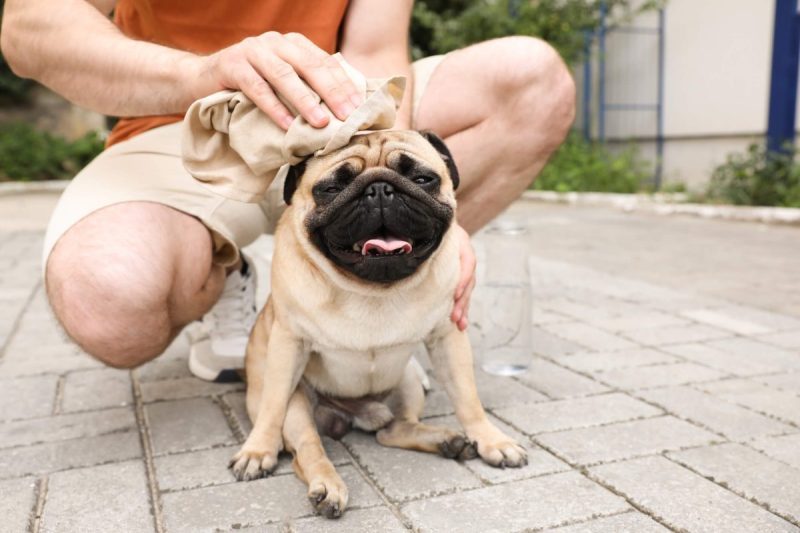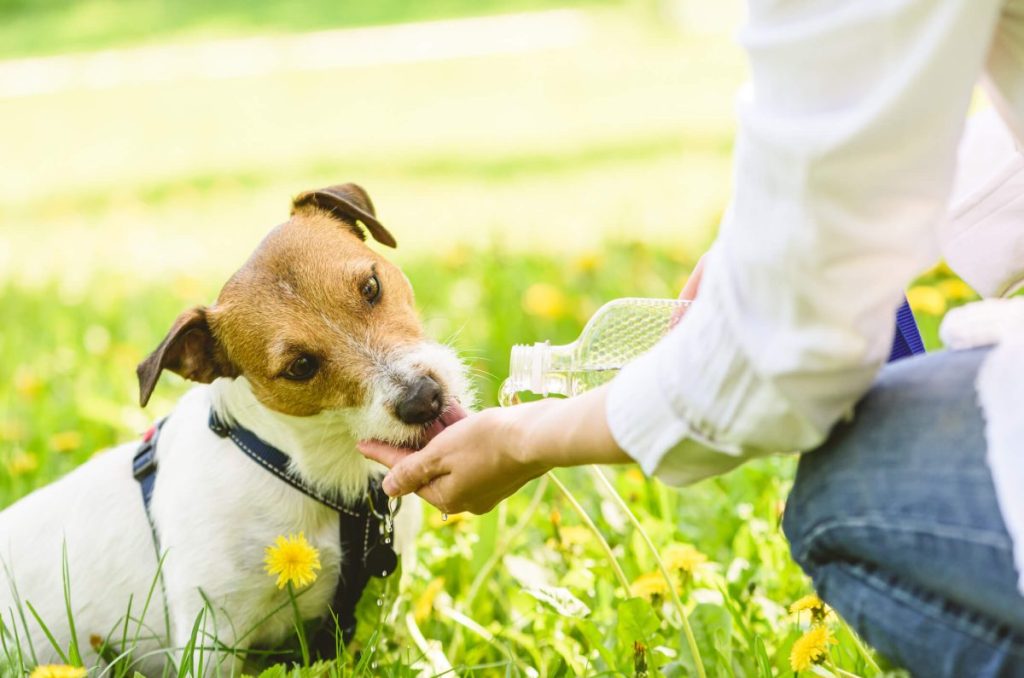
Heat stroke is a life-threatening condition that occurs when a dog’s body temperature rises to dangerously high levels, typically over 106°F or 41.1°C. Unlike humans, dogs cannot cool down effectively by sweating. Instead, they primarily regulate their body temperature through panting and limited sweating through their paw pads. When these natural cooling mechanisms become overwhelmed, dogs can suffer from heat exhaustion, which may rapidly progress to heat stroke. Without prompt treatment, heat stroke can cause severe organ damage and may even be fatal.
Here’s what you should know about the symptoms, causes, and treatments for heatstroke in dogs.
Symptoms of heat stroke in dogs
Before taking a look at the symptoms of heat stroke, it’s helpful to know how the condition differs from hyperthermia and heat exhaustion, as these terms are often used interchangeably. Hyperthermia simply means a higher-than-normal body temperature, which can happen for many reasons, like exercise, fever, or hot weather. Accordingly, heat exhaustion and heat stroke are specific types of hyperthermia caused by excessive heat exposure. Heat exhaustion is a milder condition that happens when a dog’s body overheats but has not yet reached critical levels. Heat stroke, on the other hand, is more severe and can be life-threatening.
Signs that a dog may be experiencing heat stroke include:
- Excessive panting
- Rapid heart rate
- Drooling
- Difficulty breathing
- Bright red or pale gums
- Disorientation
- Dehydration
- Lethargy and weakness
- Dizziness or confusion
- Vomiting
- Diarrhea
- Collapse or seizure
- Elevated body temperature
Causes of heat stroke in dogs

Several factors can contribute to the onset of heatstroke in dogs. These include:
- High environmental temperatures: On hot days, especially when humidity is high, dogs can overheat rapidly. Leaving a dog in a parked car, even for a short time, can cause their body temperature to rise dangerously fast, resulting in heatstroke. This is because the temperature inside a car can soar well above the outside temperature within minutes.
- Breed predisposition: Certain dog breeds are more prone to heat stroke due to their physical characteristics. Brachycephalic breeds — such as Bulldogs, Pugs, and Boxers — have shorter noses, which makes it more difficult for them to cool down through panting. Additionally, dogs with thick or double coats — like Huskies, Chow Chows, or Newfoundlands — are also at higher risk in hot climates.
- Excessive physical activity: Dogs may become overheated if they run or play too hard when the weather is warm. As such, over-exercising, particularly during the hottest parts of the day, can lead to heat stroke.
- Medical conditions and age: Dogs with pre-existing medical conditions, like heart or respiratory disease, and older dogs may not be able to regulate their body temperature as effectively. Puppies also have a higher risk because they may not yet have developed efficient cooling mechanisms.
- Obesity: Overweight dogs have a harder time regulating their body temperature due to the extra insulation of fat, which retains heat. This makes them more susceptible to heat-related illnesses.
- Inappropriate housing: Dogs kept in poorly ventilated or cramped spaces, such as kennels or small rooms without airflow, can overheat quickly, particularly if these spaces are exposed to direct sunlight.
Treatments for heat stroke in dogs

If you suspect your dog is experiencing heatstroke, the first step is to relocate them to a cooler environment, preferably a shaded area or an air-conditioned space indoors. It’s important to gradually lower their body temperature, as sudden changes can be harmful.
Begin by applying cool — not cold — water to your dog’s fur and skin, focusing on areas with less fur coverage, such as the belly and paws. Avoid using ice-cold water because it can cause blood vessels to constrict, potentially worsening the situation. You can also use wet towels or a fan to aid in the cooling process. Make sure your pup has access to fresh, cool water to drink, but avoid forcing them to drink large amounts at once as this could lead to choking or other issues.
Continue monitoring your dog’s body temperature using a rectal thermometer. Once the temperature drops to around 103°F, you should stop the cooling process to prevent hypothermia. Even if your dog’s condition seems to improve, you’ll want to seek veterinary care as soon as possible. Your veterinarian will likely perform a thorough examination and may administer intravenous fluids to rehydrate and stabilize your dog. They may also conduct blood tests to assess organ function and any potential damage caused by the heat stroke. In some cases, medications might be necessary to manage symptoms or complications. Keep in mind, quick and effective treatment can significantly improve your dog’s chances of a full recovery without lasting health issues.
How to prevent heat stroke in dogs?
Dogs who have suffered from heat stroke are at greater risk of experiencing it again. Therefore, it’s crucial to take proper steps to prevent future occurrences. Here are some practical tips to ensure your pet stays cool and healthy during hot weather:
- Provide plenty of water: Always make sure your dog has access to fresh and cool water, especially during hot days. Dehydration can set in quickly, so keep an eye on their water bowl and refill it as needed.
- Create a cool environment: Ensure your pooch has a shady spot to rest when they are outside. A tree or an umbrella can help protect your dog from direct sunlight. Indoors, you can use fans or air conditioning to keep the environment cool. If your home gets too warm, consider taking them to a cooler area, like a basement.
- Avoid peak heat: Plan walks and outdoor activities for the early morning or late evening when temperatures are lower. The sun is strongest between 10 AM and 4 PM, so it’s best to avoid strenuous activity during these hours.
- Never leave your dog in the car: Even if it doesn’t seem too hot outside, temperatures inside a car can rise rapidly. Leaving your pup in a car — even with the windows cracked — is extremely dangerous and can lead to heat stroke in a very short time.
- Use cooling products: Consider using cooling mats, vests, or bandanas. These items can help lower your dog’s body temperature when they are outdoors or in warm environments.
Remember to monitor your dog’s behavior closely and stay alert for signs of heat stroke. If you observe anything out of the ordinary, move your dog to a cooler area right away and contact your vet for guidance.